

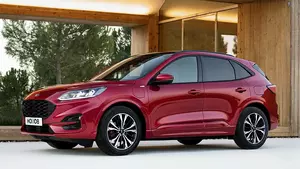
| Engine | 0—60 mph | 0—100 km/h | Top Speed | Averange Economy |
|---|---|---|---|---|
| 2.5 Duratec | 8.7 s | 9.2 s | 124 mph | - |
| 1.5 EcoBoost | 9.2 s | 9.7 s | 121 mph | - |
| 2.0 EcoBlue | 8.3 s | 8.7 s | 129 mph | - |
| 1.5 EcoBlue | 11.1 s | 11.7 s | 112 mph | - |
| Engine | 2.5 Duratec |
|---|---|
| 0—60 mph | 8.7 s |
| 0—100 km/h | 9.2 s |
| Top Speed | 124 mph |
| Averange Economy | - |
| Engine | 1.5 EcoBoost |
| 0—60 mph | 9.2 s |
| 0—100 km/h | 9.7 s |
| Top Speed | 121 mph |
| Averange Economy | - |
| Engine | 2.0 EcoBlue |
| 0—60 mph | 8.3 s |
| 0—100 km/h | 8.7 s |
| Top Speed | 129 mph |
| Averange Economy | - |
| Engine | 1.5 EcoBlue |
| 0—60 mph | 11.1 s |
| 0—100 km/h | 11.7 s |
| Top Speed | 112 mph |
| Averange Economy | - |
In 2020, Ford Kuga 0-60 acceleration was between 8.3 and 11.1 seconds.
Ford Kuga 0-60 mph was up to 17% slower in 2020 than world's average.
In 2020, Ford Kuga 0-60 mph to car weight ratio is shown below:
| Vehicle | Acceleration 0—60 mph (0—100 km/h) | Maximum speed | Acceleration to passenger ratio | Fuel consumption at high speed | Fuel type / gearbox |
|---|---|---|---|---|---|
| 2.5 Duratec | 8.7 s to 60 mph (9.2 s to 100 km/h) | 124 mph (200 km/h) | 1.7 s to 60 mph / person | - | petrol / electricity / 1 CVT |
| 1.5 EcoBoost | 9.2 s to 60 mph (9.7 s to 100 km/h) | 121 mph (195 km/h) | 1.8 s to 60 mph / person | - | Petrol (Gasoline) |
| 2.0 EcoBlue | 8.3 s to 60 mph (8.7 s to 100 km/h) | 129 mph (208 km/h) | 1.7 s to 60 mph / person | - | Diesel / 8 |
| 1.5 EcoBlue | 11.1 s to 60 mph (11.7 s to 100 km/h) | 112 mph (180 km/h) | 2.2 s to 60 mph / person | - | Diesel |
| Vehicle | 2.5 Duratec |
|---|---|
| Acceleration 0-60 mph (0-100 km/h) | 8.7 s to 60 mph (9.2 s to 100 km/h) |
| Maximum speed | 124 mph (200 km/h) |
| Acceleration to passenger ratio | 1.7 s to 60 mph / person |
| Fuel consumption at high speed | - |
| Fuel type / gearbox | petrol / electricity / 1 CVT |
| Vehicle | 1.5 EcoBoost |
| Acceleration 0-60 mph (0-100 km/h) | 9.2 s to 60 mph (9.7 s to 100 km/h) |
| Maximum speed | 121 mph (195 km/h) |
| Acceleration to passenger ratio | 1.8 s to 60 mph / person |
| Fuel consumption at high speed | - |
| Fuel type / gearbox | Petrol (Gasoline) |
| Vehicle | 2.0 EcoBlue |
| Acceleration 0-60 mph (0-100 km/h) | 8.3 s to 60 mph (8.7 s to 100 km/h) |
| Maximum speed | 129 mph (208 km/h) |
| Acceleration to passenger ratio | 1.7 s to 60 mph / person |
| Fuel consumption at high speed | - |
| Fuel type / gearbox | Diesel / 8 |
| Vehicle | 1.5 EcoBlue |
| Acceleration 0-60 mph (0-100 km/h) | 11.1 s to 60 mph (11.7 s to 100 km/h) |
| Maximum speed | 112 mph (180 km/h) |
| Acceleration to passenger ratio | 2.2 s to 60 mph / person |
| Fuel consumption at high speed | - |
| Fuel type / gearbox | Diesel |
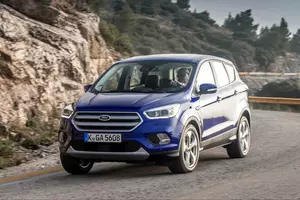
| Engine | 0—60 mph | 0—100 km/h | Top Speed | Averange Economy |
|---|---|---|---|---|
| 1.5 EcoBoost | 9.2 s | 9.7 s | 121 mph | 37 mpg |
| 1.5 TDCI | 12.1 s | 12.7 s | 107 mph | 53 mpg |
| 2.0 TDCI | 9.6 s | 10.1 s | 121 mph | 50 mpg |
| 2.0 EcoBoost | 8.4 s | 8.8 s | 132 mph | 27 mpg |
| Engine | 1.5 EcoBoost |
|---|---|
| 0—60 mph | 9.2 s |
| 0—100 km/h | 9.7 s |
| Top Speed | 121 mph |
| Averange Economy | 37 mpg |
| Engine | 1.5 TDCI |
| 0—60 mph | 12.1 s |
| 0—100 km/h | 12.7 s |
| Top Speed | 107 mph |
| Averange Economy | 53 mpg |
| Engine | 2.0 TDCI |
| 0—60 mph | 9.6 s |
| 0—100 km/h | 10.1 s |
| Top Speed | 121 mph |
| Averange Economy | 50 mpg |
| Engine | 2.0 EcoBoost |
| 0—60 mph | 8.4 s |
| 0—100 km/h | 8.8 s |
| Top Speed | 132 mph |
| Averange Economy | 27 mpg |
In 2016, Ford Kuga 0-60 acceleration was between 8.4 and 12.1 seconds.
Ford Kuga 0-60 mph was up to 27% slower in 2016 than world's average.
In 2016, Ford Kuga 0-60 mph to car weight ratio is shown below:
| Vehicle | Acceleration 0—60 mph (0—100 km/h) | Maximum speed | Acceleration to passenger ratio | Fuel consumption at high speed | Fuel type / gearbox |
|---|---|---|---|---|---|
| 1.5 EcoBoost | 9.2 s to 60 mph (9.7 s to 100 km/h) | 121 mph (195 km/h) | 1.8 s to 60 mph / person | 44 mpg (5.4 L per 100 km) | Petrol (Gasoline) |
| 1.5 TDCI | 12.1 s to 60 mph (12.7 s to 100 km/h) | 107 mph (173 km/h) | 2.4 s to 60 mph / person | 56 mpg (4.2 L per 100 km) | Diesel |
| 2.0 TDCI | 9.6 s to 60 mph (10.1 s to 100 km/h) | 121 mph (194 km/h) | 1.9 s to 60 mph / person | 55 mpg (4.3 L per 100 km) | Diesel |
| 2.0 EcoBoost | 8.4 s to 60 mph (8.8 s to 100 km/h) | 132 mph (212 km/h) | 1.7 s to 60 mph / person | 33 mpg (7.2 L per 100 km) | Petrol (Gasoline) / 6 |
| Vehicle | 1.5 EcoBoost |
|---|---|
| Acceleration 0-60 mph (0-100 km/h) | 9.2 s to 60 mph (9.7 s to 100 km/h) |
| Maximum speed | 121 mph (195 km/h) |
| Acceleration to passenger ratio | 1.8 s to 60 mph / person |
| Fuel consumption at high speed | 44 mpg (5.4 L per 100 km) |
| Fuel type / gearbox | Petrol (Gasoline) |
| Vehicle | 1.5 TDCI |
| Acceleration 0-60 mph (0-100 km/h) | 12.1 s to 60 mph (12.7 s to 100 km/h) |
| Maximum speed | 107 mph (173 km/h) |
| Acceleration to passenger ratio | 2.4 s to 60 mph / person |
| Fuel consumption at high speed | 56 mpg (4.2 L per 100 km) |
| Fuel type / gearbox | Diesel |
| Vehicle | 2.0 TDCI |
| Acceleration 0-60 mph (0-100 km/h) | 9.6 s to 60 mph (10.1 s to 100 km/h) |
| Maximum speed | 121 mph (194 km/h) |
| Acceleration to passenger ratio | 1.9 s to 60 mph / person |
| Fuel consumption at high speed | 55 mpg (4.3 L per 100 km) |
| Fuel type / gearbox | Diesel |
| Vehicle | 2.0 EcoBoost |
| Acceleration 0-60 mph (0-100 km/h) | 8.4 s to 60 mph (8.8 s to 100 km/h) |
| Maximum speed | 132 mph (212 km/h) |
| Acceleration to passenger ratio | 1.7 s to 60 mph / person |
| Fuel consumption at high speed | 33 mpg (7.2 L per 100 km) |
| Fuel type / gearbox | Petrol (Gasoline) / 6 |
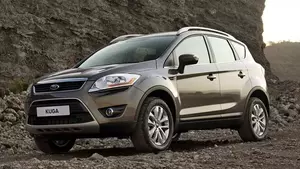
| Engine | 0—60 mph | 0—100 km/h | Top Speed | Averange Economy |
|---|---|---|---|---|
| 1.6 EcoBoost | 9.2 s | 9.7 s | 124 mph | 31 mpg |
| 2.0 TDCi | 9.9 s | 10.4 s | 122 mph | 38 mpg |
| Engine | 1.6 EcoBoost |
|---|---|
| 0—60 mph | 9.2 s |
| 0—100 km/h | 9.7 s |
| Top Speed | 124 mph |
| Averange Economy | 31 mpg |
| Engine | 2.0 TDCi |
| 0—60 mph | 9.9 s |
| 0—100 km/h | 10.4 s |
| Top Speed | 122 mph |
| Averange Economy | 38 mpg |
In 2012, Ford Kuga 0-60 acceleration was between 9.2 and 9.9 seconds.
Ford Kuga 0-60 mph was up to 4% slower in 2012 than world's average.
In 2012, Ford Kuga 0-60 mph to car weight ratio is shown below:
| Vehicle | Acceleration 0—60 mph (0—100 km/h) | Maximum speed | Acceleration to passenger ratio | Fuel consumption at high speed | Fuel type / gearbox |
|---|---|---|---|---|---|
| 1.6 EcoBoost | 9.2 s to 60 mph (9.7 s to 100 km/h) | 124 mph (200 km/h) | 1.8 s to 60 mph / person | 37 mpg (6.3 L per 100 km) | Petrol (Gasoline) / 6 |
| 2.0 TDCi | 9.9 s to 60 mph (10.4 s to 100 km/h) | 122 mph (196 km/h) | 2 s to 60 mph / person | 43 mpg (5.5 L per 100 km) | Diesel / 6 |
| Vehicle | 1.6 EcoBoost |
|---|---|
| Acceleration 0-60 mph (0-100 km/h) | 9.2 s to 60 mph (9.7 s to 100 km/h) |
| Maximum speed | 124 mph (200 km/h) |
| Acceleration to passenger ratio | 1.8 s to 60 mph / person |
| Fuel consumption at high speed | 37 mpg (6.3 L per 100 km) |
| Fuel type / gearbox | Petrol (Gasoline) / 6 |
| Vehicle | 2.0 TDCi |
| Acceleration 0-60 mph (0-100 km/h) | 9.9 s to 60 mph (10.4 s to 100 km/h) |
| Maximum speed | 122 mph (196 km/h) |
| Acceleration to passenger ratio | 2 s to 60 mph / person |
| Fuel consumption at high speed | 43 mpg (5.5 L per 100 km) |
| Fuel type / gearbox | Diesel / 6 |
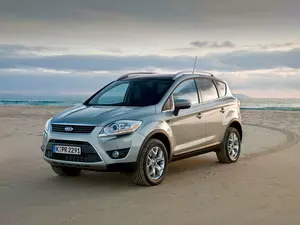
| Engine | 0—60 mph | 0—100 km/h | Top Speed | Averange Economy |
|---|---|---|---|---|
| 2.0 Duratorq TDCi | 10.6 s | 11.2 s | 116 mph | 38 mpg |
| Engine | 2.0 Duratorq TDCi |
|---|---|
| 0—60 mph | 10.6 s |
| 0—100 km/h | 11.2 s |
| Top Speed | 116 mph |
| Averange Economy | 38 mpg |
In 2010 Ford Kuga 0-60 acceleration was 10.6 seconds.
Ford Kuga 0-60 mph was up to 11% slower in 2010 than world's average.
In 2010, Ford Kuga 0-60 mph to car weight ratio is shown below:
| Vehicle | Acceleration 0—60 mph (0—100 km/h) | Maximum speed | Acceleration to passenger ratio | Fuel consumption at high speed | Fuel type / gearbox |
|---|---|---|---|---|---|
| 2.0 Duratorq TDCi | 10.6 s to 60 mph (11.2 s to 100 km/h) | 116 mph (187 km/h) | 2.1 s to 60 mph / person | 43 mpg (5.5 L per 100 km) | Diesel / 6 |
| Vehicle | 2.0 Duratorq TDCi |
|---|---|
| Acceleration 0-60 mph (0-100 km/h) | 10.6 s to 60 mph (11.2 s to 100 km/h) |
| Maximum speed | 116 mph (187 km/h) |
| Acceleration to passenger ratio | 2.1 s to 60 mph / person |
| Fuel consumption at high speed | 43 mpg (5.5 L per 100 km) |
| Fuel type / gearbox | Diesel / 6 |
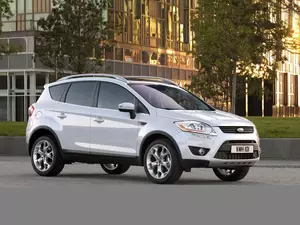
| Engine | 0—60 mph | 0—100 km/h | Top Speed | Averange Economy |
|---|---|---|---|---|
| 2.5 i 20V | 8.4 s | 8.8 s | 127 mph | 23 mpg |
| 2.0 TDCi | 10.2 s | 10.7 s | 112 mph | 37 mpg |
| Engine | 2.5 i 20V |
|---|---|
| 0—60 mph | 8.4 s |
| 0—100 km/h | 8.8 s |
| Top Speed | 127 mph |
| Averange Economy | 23 mpg |
| Engine | 2.0 TDCi |
| 0—60 mph | 10.2 s |
| 0—100 km/h | 10.7 s |
| Top Speed | 112 mph |
| Averange Economy | 37 mpg |
In 2008, Ford Kuga 0-60 acceleration was between 8.4 and 10.2 seconds.
Ford Kuga 0-60 mph was up to 7% slower in 2008 than world's average.
In 2008, Ford Kuga 0-60 mph to car weight ratio is shown below:
| Vehicle | Acceleration 0—60 mph (0—100 km/h) | Maximum speed | Acceleration to passenger ratio | Fuel consumption at high speed | Fuel type / gearbox |
|---|---|---|---|---|---|
| 2.5 i 20V | 8.4 s to 60 mph (8.8 s to 100 km/h) | 127 mph (205 km/h) | 1.7 s to 60 mph / person | 30 mpg (7.8 L per 100 km) | Petrol (Gasoline) / 5 |
| 2.0 TDCi | 10.2 s to 60 mph (10.7 s to 100 km/h) | 112 mph (180 km/h) | 2 s to 60 mph / person | 44 mpg (5.4 L per 100 km) | Diesel |
| Vehicle | 2.5 i 20V |
|---|---|
| Acceleration 0-60 mph (0-100 km/h) | 8.4 s to 60 mph (8.8 s to 100 km/h) |
| Maximum speed | 127 mph (205 km/h) |
| Acceleration to passenger ratio | 1.7 s to 60 mph / person |
| Fuel consumption at high speed | 30 mpg (7.8 L per 100 km) |
| Fuel type / gearbox | Petrol (Gasoline) / 5 |
| Vehicle | 2.0 TDCi |
| Acceleration 0-60 mph (0-100 km/h) | 10.2 s to 60 mph (10.7 s to 100 km/h) |
| Maximum speed | 112 mph (180 km/h) |
| Acceleration to passenger ratio | 2 s to 60 mph / person |
| Fuel consumption at high speed | 44 mpg (5.4 L per 100 km) |
| Fuel type / gearbox | Diesel |